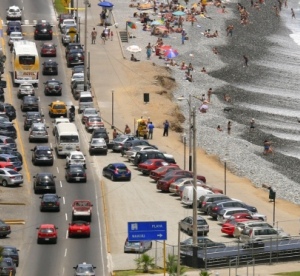Prize fund gives students green light to study gridlock in Peru

Peru is famous for the Inca Trail, a supply route once part of an advanced empire. But two Imperial students went to examine much more modern roads.
Maud Macary and Melina Cristina (both MSc Transport, Department of Civil and Environmental Engineering) spent five weeks in Peru’s capital Lima getting to grips with gridlock as they researched the city’s transport network for their dissertations.
The sprawling capital provided a fascinating case study for the two students. With a population of 9.5 million, one-third of Peru’s population, the city’s residents use 425 bus routes operated by 307 companies. Their expedition is thanks to the Basu Prize for Civil Engineering. The prize, offered through the generosity of alumnus Dr Amiya Basu, funds an overseas research trip for Master’s students’ dissertation projects.

Traffic jam at Miraflores Beach, Lima
Road space in Lima is fought over by 60,000 micros (old school buses from the USA), combis (van-sized taxis which often pick up and drop off passengers without stopping), and thousands of taxis. Each year sees over 55,000 transit accidents and 800 fatalities. The city’s government is currently implementing infrastructure reform to tackle these problems, and it is this process that attracted the intrepid Imperial students.
Maud looked at the bus and tram network. By visiting the city, she was able to meet the local authorities and sit in on planning meetings, before experiencing the oversupply problem first hand. Her research took her all over the city, and she was able to analyse the feasibility of government plans to formalise the bus system.
"The challenges the city faces are huge, and it was useful to observe them for myself and meet the people trying to solve the problems"
– Maud MacAry
Basu Prize Winner
Maud said “It was very interesting to visit the city, and I was able to gather valuable material for my work. A city like Lima has a growing economy, but nothing like the resources of London or Paris, so it was fascinating to see how investments were planned differently. The challenges the city faces are huge, and it was useful to observe them for myself and meet the people trying to solve the problems.”
Melina examined the experience of pedestrians in Lima. At least 25% of the population make the journey to work or school on foot, but the design of the city favours vehicles. Pedestrians account for 78% of traffic accident fatalities. In her research, Melina focussed on potentially unsafe pedestrian infrastructure, such as badly placed barriers or missing pavements. She also surveyed local residents to measure their perceptions of pedestrian safety, and examined the Public Transit Code which sets out the rules for pedestrians.
Melina said “I was surprised by some of the rules. For example, pedestrians are expected to judge the distance between their crossing place and the approaching car. The law says pedestrians can cross if the distance from the car is not less than 40m, but it’s unrealistic to expect pedestrians to make this judgement.”
Both students are writing up their dissertations which are due in late August. They both acknowledged the advantages of conducting research abroad. Melina said “the trip made a real difference to our work. Being in the city challenged our assumptions and gave us the opportunity to meet both the people driving change and those affected by it. We are very grateful to have won the prize, it was a fantastic experience.”
Article text (excluding photos or graphics) © Imperial College London.
Photos and graphics subject to third party copyright used with permission or © Imperial College London.
Reporter
Calum MacLeod
Department of Electrical and Electronic Engineering